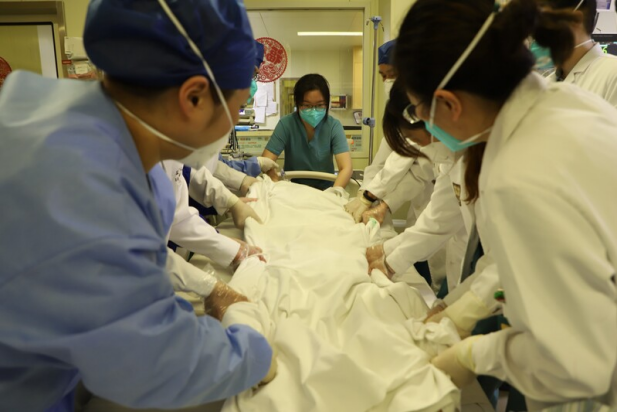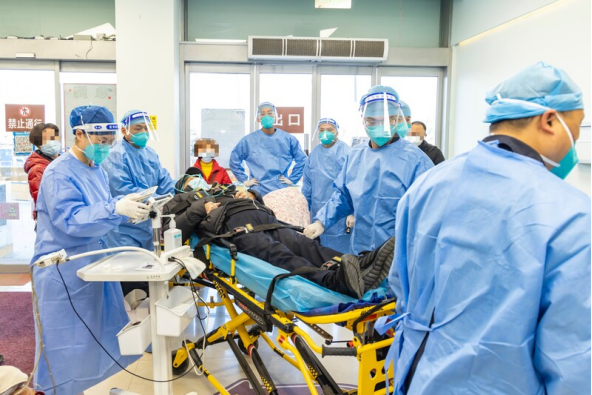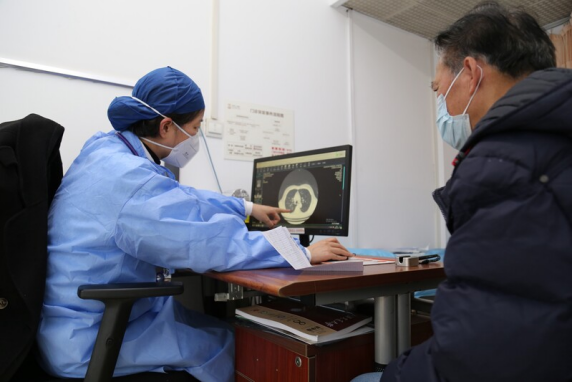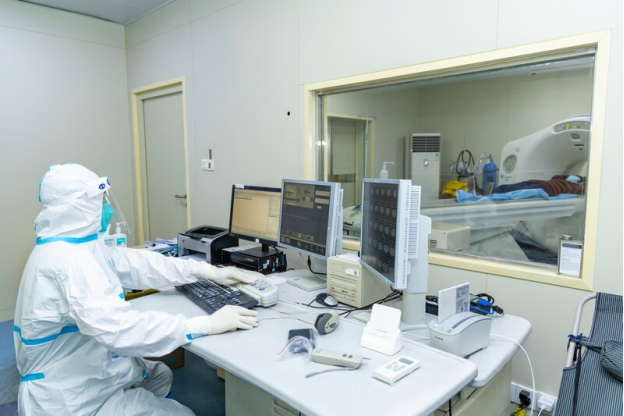- News
Medical Staff at Shanghai General Hospital Make Every Effort to Save Patients with Critical Illness
Link of the Original Article:
https://www.shobserver.com/staticsg/res/html/web/newsDetail.html?id=569390
As the task for infection prevention shifted to prevention of critical illness, ensuring the treatment of patients with acute and critical illnesses has become a top priority for medical institutions at present stage. Recently, Shanghai General Hospital has unified the whole hospital into one force. Every medical workers and their teams improve efficiency to "speedy diagnosis, speedy admission, speedy treatment" to make every effort to ensure that the "life channel" for emergency and critical care smooth and efficient."This patient's oxygen saturation has improved significantly after prone ventilation, so we can help him turn his body back." On the evening of January 4, Wang Ruilan, Director of the Emergency and Critical Care Department of Shanghai General Hospital, was leading a team to conduct a "night check" in the intensive care unit. After nearly 30 hours of prone ventilation, the oxygen saturation of a patient with severe pneumonia increased from 90% to 96%, dyspnea relieved significantly, and arterial blood gas index normalized. More than ten medical workers stood besides the bed and carefully turned the patient from prone to supine, and then performed tracheal intubation care for him.

The same scene also happened in the intensive care unit of Songjiang Hospital. Hong Jiang, director of the emergency critical care unit in the southern campus of Shanghai General Hospital, said that most of the patients in the ICU are elderly people with multiple diseases, some with significant lung disease, some with heart disease, some with gastrointestinal bleeding, and some requiring continuous bedside dialysis treatment. In response, the health care team then took targeted treatment one by one.
"In the intensive care unit, resuscitation room and emergency ward, medical care has to be highly alert to the indicators of the patients and always observe the subtle changes in their conditions." Wang Ruilan said, "In the face of the dramatic increase in the number of patients, all we can do is to do our best to save the patients.
"Speed up the turnaround" has become the core of the emergency work: faster pre-screening and triage, initiatives such as faster examination and testing, faster dispensing and infusion, faster ward admission are centered around the notion of "quick diagnosis, quick admission, quick treatment".

"If the work is faster, it will speed up the whole emergency process."
In the resuscitation room, which is the "main body" of emergency medical care along with the intensive care unit, the reporter saw that the previous patient had just been sent into the room and the automatic door had not been completely closed, and the nurses ran all the way to hand over with non-stop 120 ambulance sending patients one after another.
According to Yang Jiong and Lu Weijue, the two head nurses, since New Year's Day, the number of emergency cases in Hongkou and Songjiang campuses increased by 2,000, with about 190 ambulances coming to the hospital every day.

In the emergency lobby of Songjiang campus, two senior nurses are "stationed" at the entrance of the emergency corridor. They are waiting for the incoming ambulances, while emergency equipment such as oxygen cylinders are placed directly at the entrance of the emergency corridor. Patients who are assessed to use pre-screening can complete an ECG examination before admission. If the results are abnormal, they will be sent directly to the resuscitation room or the tertiary consultation room for priority treatment. "By taking an extra step forward, we can screen out critically ill patients more quickly so they can have appropriate treatment as soon as possible." Fan Renjing, deputy chief nurse of the South Emergency Department said.
Hu Meiqin, head nurse of the northern emergency infusion room in the Hongkou campus said that recently many patients tripled need infusions. The nurses in the infusion room do not have time to eat or drink or go to the bathroom during the workday. "If we work a little faster, patients can get their fluids as soon as possible, and if every rescuing step is speeded up a little, the whole emergency can run a little faster." Hu Meiqin said.It is reported that in order to speed up the efficiency of the turnover of the infusion room, the two campuses of Shanghai General Hospital have almost doubled the capacity of the infusion position, from the original total of 130 seats to nearly 200, and make full use of the existing space to set up additional rehydration areas.
When the emergency medical team did its best, the hospital coordinated quickly: a special working group for emergency triage was set up, led by the vice presidents, with the participation of departments such as the medical office and the nursing department, working on site in the emergency lobby every day to supervise and coordinate the triage of emergency patients, ensuring that the first gate for treating patients was kept open and that inpatient beds were used in the most reasonable way. At the same time, the hospital tried to practice of admitting patients by discipline and specialty, relying on the advantages of specialties such as the Department of Emergency Critical Care and the Department of Respiratory and Critical Care Medicine, and uniting with other disciplines to release more physical space for the treatment of emergency patients.
After the hospital-wide wards were deployed, Zhang Min, director of the respiratory department at Hongkou Campus, and Ben Suqin, executive director of the respiratory department at Songjiang Campus, became even busier. The respiratory departments of both campuses have added additional wards, doubled the number of beds, and the departments have also taken on hospital-wide bronchoscopy operations, consultation of patients with new coronary infections and a large number of outpatient consultations for patients with new coronary common and moderated cases, resulting in a surge in workload. The two directors led the team to quickly complete the expansion of the ward. With the joint efforts, the number of respiratory beds in Hongkou Campus increased from the original 60 beds to 120, and in Songjiang Campus from 16 to 46, which greatly enhanced the capacity of admitting and treating patients with new coronary infections.

In order to help non-emergency and respiratory "cross-border" doctors and nurses take better care of patients with NICs, Zhang Min not only used his time off to lead his team to establish NICs consultation sets and medical history templates, but also took time to develop a guideline and conduct intensive training on the standardized process of NICs treatment. At the same time, Zhang Min opened a special pulmonary imaging clinic, which sees more than 100 patients daily, diverting some of the patient pressure for the emergency department. "Try our best to homogenize the treatment of patients admitted to the hospital and the whole hospital for new coronary treatment, so that the hospital's comprehensive treatment capacity and resource turnover can also be further strengthened and speeded up." Zhang Min said.
Ben Suqin is also the director of the Infectious Diseases Department in the south campus. Every day when she arrives at the hospital, she will first conduct an early check in the respiratory ward, then go to the fever detention ward to check in, and at the same time, she has to promptly respond to the demand for consultation of patients with new coronary heart disease, which has increased three times compared to the original one.
"If the imaging and test reports read faster, the speed of first-line screening and diagnosis will be even faster."

Imaging examination and lab tests are also essential and important parts of emergency care. With the surge in patients, the number of CT exams has increased to three to four times what it would normally be. Zhang Jiayin, director of the radiology department, said that in the face of the sudden increase in demand for CT examinations, the radiology department opened a total of five additional CT devices in the two hospital campus, and the number of technologists scheduled also increased to three times the usual number. When the situation was the most severe, almost every technologist was on duty with illness and did not leave the operating table without a high fever.
In order to reduce the pressure on the emergency department and speed up the triage of staff and the issuance of test results, the radiology department has introduced a special test for "pneumonia screening chest CT" in the outpatient clinic, and in principle, the diagnostic report can be issued within 2 hours.
Arterial blood gas and cardiac enzyme profile are the two most valuable indicators for clinical assessment of the diagnosis of critical pneumonia, and the number of emergency tests has increased significantly recently compared to the previous ones. In particular, arterial blood gas analysis requires the test technician to collect arterial blood, and the majority of emergency patients are elderly, with poor circulation and low cooperation, making blood collection quite difficult. Under the leadership of Director Lou Jiatao, the laboratory team optimized the emergency testing process, collaborated with emergency testing and large laboratory testing, and increased the amount of emergency testing shifts, and was able to withstand the demand for emergency outpatient testing, which was five times higher than usual.

In the overall expansion of testing manpower at the same time, the laboratory department real-time dynamic adjustment of outpatient, emergency and fever staffing, to ensure that manpower is used on the "cutting edge". For example, emergency tests are linked to outpatient tests, so that if there is a backlog of emergency tests, the samples are immediately transferred to the large outpatient testing facilities for analysis. In this way, the speed of all emergency tests is guaranteed.
Faced with the severe challenge of emergency and critical care, Shanghai General Hospital strives to maximize the efficiency of available medical resources and firmly guard the bottom line of patient life protection.
Correspondents: Yang Hu, Yangzi Huang
